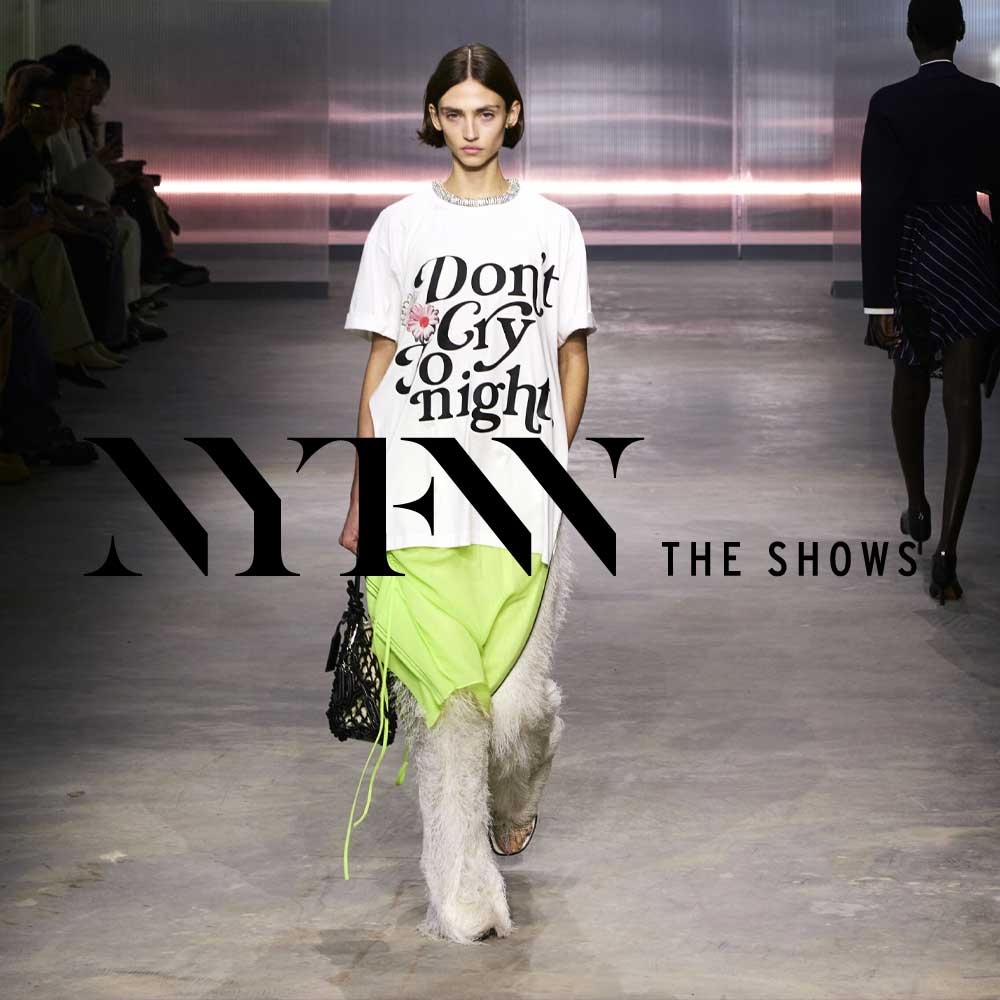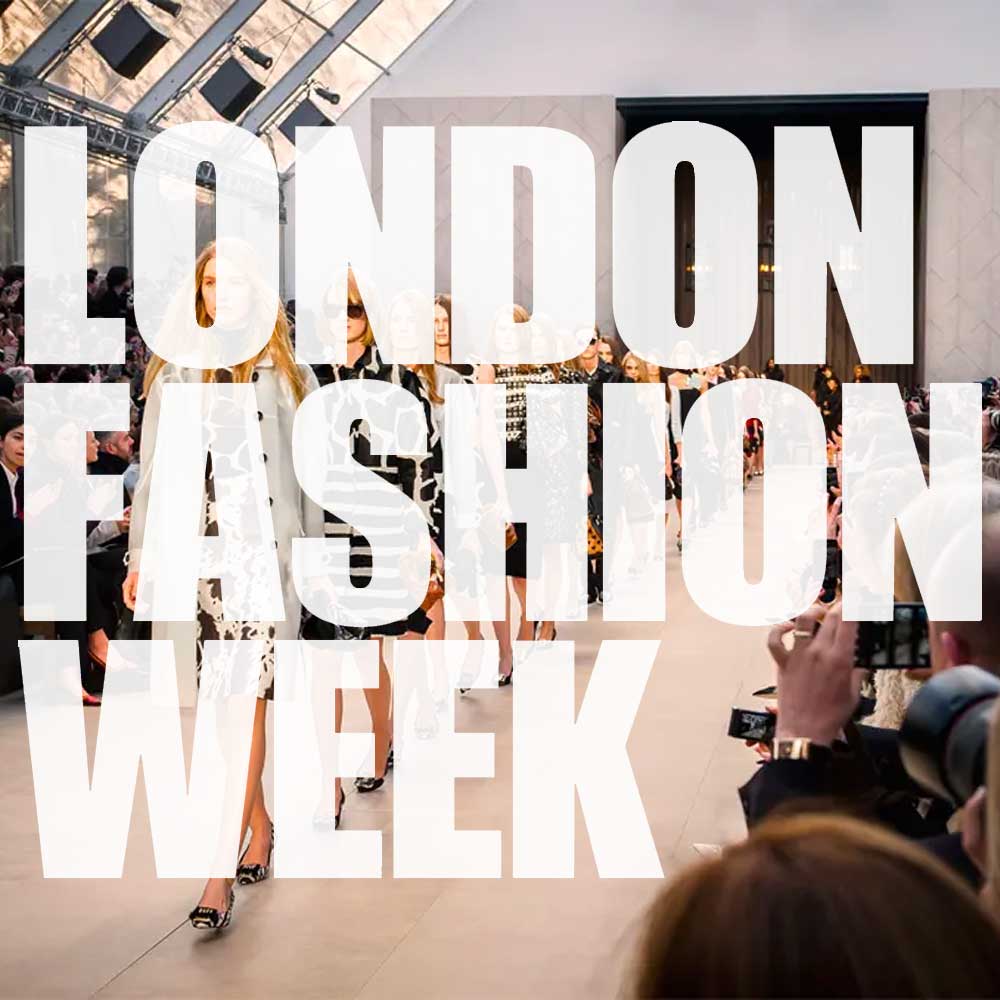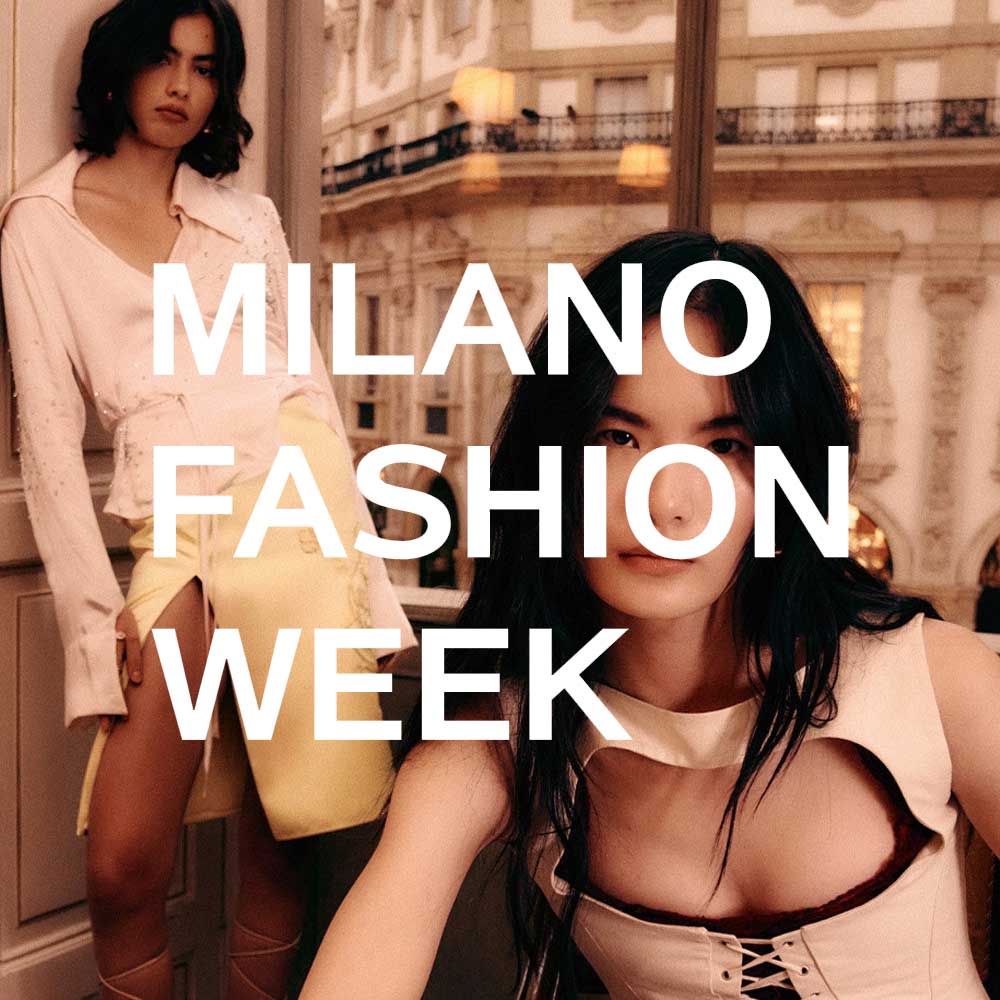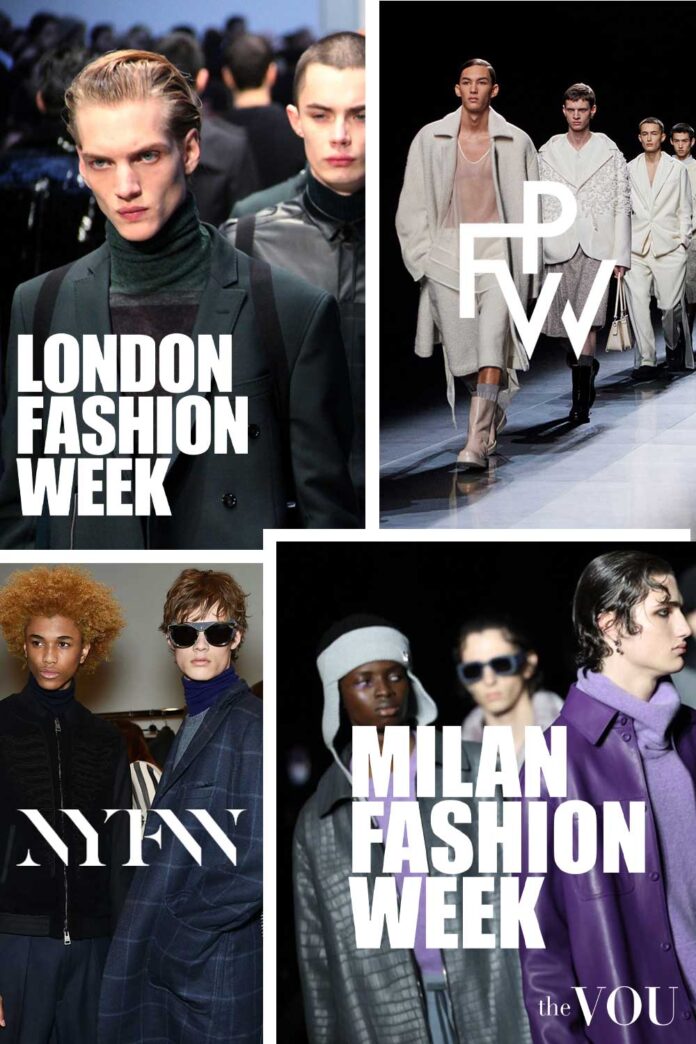A fashion week is a bi-annual fashion industry event organised in large cities worldwide, during which several fashion shows take place with models parading on the runway designers’ upcoming fashion collections, showcasing them to buyers and media.
The world’s most influential Fashion Week cities are Paris, London, New York, and Milan known as the Big Four Fashion Week cities.
Fashion weeks are designers’ favourite way to showcase their unique creations, combinations of classic fashion styles, current styles, and emerging fashion trends.
Modern men interested in shopping high-end fashion creations before the masses should keep a close eye on the world’s fashion weeks.
Biggest Fashion Weeks in the World
Since the advent of fashion, designers showcased at clients’ homes via small fashion parades (défilés de mode’ in French).
Over time, these home-based fashion shows evolved into weekend-long social events that powerful and influential people attended.
The concept of weekend-long fashion shows reached the United States, and in 1903, Ehrich Brothers, a Manhattan clothing shop, organised the country’s first fashion event dedicated to middle-class women.
The shows were hugely popular, leading to the launch of the world’s first Fashion Week in New York City on July 19, 1943.
Nowadays, New York City, Paris, London, and Milan organise the world’s most famous fashion weeks (known as the “Big Four” Fashion Weeks) with shows that impact upcoming fashion trends.
The Big Four fashion weeks benefit from excellent funding, infrastructure, media coverage, top fashion critics, trendsetters, and influencers support, awards, and the shows of the most famous fashion designers of modern times.
1. New York Fashion Week
The world’s first ‘Fashion Week’ event occurred in New York City on July 19, 1943, in continuation to Eleanor Lambert’s work, who set up the New York Dress Institute in 1941 and the Press Week in 1943.
The purpose of New York Fashion Week was to provide fashion buyers with alternatives to French fashion during World War II, when workers in the fashion industry could not travel to Paris.

The 1990s yielded plenty of memorable moments, from Marc Jacobs’s infamous, grunge-inspired spring 1993 Perry Ellis show to Kate Moss strolling down the catwalk at Calvin Klein.
In addition to the rise of supermodels, the event was marked by front-row celebrities like Julia Roberts, Leonardo DiCaprio, Drew Barrymore, and Mariah Carey.
The move to Bryant Park led to corporate sponsorship opportunities. In the late 1990s, the biannual event was rebranded Mercedes-Benz Fashion Week.
From 2010 to 2015, Lincoln Center was the home of New York Fashion Week—which expanded to nearly 300 shows—and since 2016, it has taken place at Tribeca Spring Studios.
2. Paris Fashion Week
By the end of the 1930s, Paris had become a hothouse of renowned fashion designers like Coco Chanel, Elsa Schiaparelli, and Madeleine Vionnet.
Between 1945 and the 70s, Parisian fashion houses shifted from small, individualised events dedicated to wealthy clients to big parties where models interacted with buyers, fashion critics, and celebrities.

Organised by the French Fashion Federation, the first Paris Fashion Week took place in 1973, October 1/9, as the ‘Battle of Versailles Fashion Show’ – a fight of sartorial nature – where the fashion tensions between Paris and New York were brought to life on stage.
The event featured Yves Saint Laurent, Emanuel Ungaro, Christian Dior, Pierre Cardin, and Hubert de Givenchy on the French side against Anne Klein, Halston, Oscar de la Renta, Bill Blass, and Stephen Burrows, representing America.
3. London Fashion Week
The first London Fashion Week was organised by the British Fashion Council in October 1983 in a car park in West London, with tents placed outside Kensington’s Commonwealth Institute.

Young fashion designers like Betty Jackson, David Fielden, and John Galliano debuted at this successful event, prompting the UK government to step in and provide official funding.
In the 90s, Alexander McQueen showcased his creations for the first time at London Fashion Week (1993), followed by Stella McCartney in 1995.
4. Milan Fashion Week
Before Milan became Italy’s fashion capital, Italian aristocrat Giovanni Battista Giorgini held several fashion shows, like the 1951 event at Palazzo Pitti in Florence, with designs from Emilio Pucci and the Fontana sisters.
However, the narrow streets forced the organisers to move the event to a bigger city.

As such, in 1958, Milan Fashion Week was launched in collaboration with Camera Nazionale della Moda Italiana.
Between the 1970s and 1990s, shows organised by Milan-based fashion designers like Giorgio Armani and Gianni Versace, featuring models like Cindy Crawford, Naomi Campbell, Christy Turlington, and Linda Evangelista, became immensely popular, cementing Milan’s status as a sartorial capital of the world.
When is the Fashion Week?
Nowadays, Fashion Week takes place twice a year, in February and March, when designers showcase their Autumn/Winter collections, and in September and October, for the Spring/Summer collections.
New York City is the first to start the Fashion Week (February 7–15), followed by London (February 15–19), Milan (February 19–25), and Paris – the last of the Big Four – closing the event (February 25-March 5).
What is the Format of the Fashion Week
While all Fashion Weeks showcase womenswear and menswear, each show depicts particularities according to the event’s location.
Paris Fashion Week is renowned for haute couture, New York Fashion Week for business and leisure fashion, London Fashion Week for highly creative fashion designers, and Milan Fashion Week for traditional fashion styles.
Apart from the Big Four Fashion Weeks, several cities worldwide organise Fashion Weeks and thematic fashion events like Miami Fashion Week and Rio Summer Fashion Week for swimwear, Indonesia Islamic Fashion Week for Muslim fashion, and Bangalore Fashion Week for festive wear.
How Many Fashion Weeks Are Around the World?
Since the 2000s, the globalization of fashion has contributed to the rise of non-traditional fashion cities and their significant relevance in the fashion calendar.
In addition to the four fashion capitals, fashion cities like Tokyo, Madrid, Berlin, Seoul, Toronto, Mumbai, Sao Paulo, and Shanghai organise impactful fashion weeks.
There are 67 fashion weeks. Here is the complete list in alphabetical order:
- 080 Barcelona Fashion (Spain)
- Afro Fashion Week Milano (Italy)
- Amsterdam Fashion Week (Netherlands)
- Arab Fashion Week (UAE)
- Athens Xclusive Designers Week (Greece)
- Austin Fashion Week (United States)
- Bangalore Fashion Week (India)
- Barcelona Bridal Week (Spain)
- Belarus Fashion Week (Belarus)
- Berlin Fashion Week (Germany)
- Bogota Fashion Week (Colombia)
- Buenos Aires Fashion Week (Argentina)
- Cheshire Fashion Week (United Kingdom)
- Chicago Midwest Fashion Week (United States)
- Columbus Fashion Week (United States)
- Copenhagen Fashion Week (Denmark)
- Couture Fashion Week (United States)
- Dakar Fashion Week (Senegal)
- Dutch Sustainable Fashion Week (Netherlands)
- Fashion Week Brooklyn (United States)
- Fashion Week El Paseo (United States)
- Fashion Week Honduras (Honduras)
- Fashion Week Stockholm (Sweden)
- Fiji Fashion Week (Fiji)
- Graduate Fashion Week (United Kingdom)
- Hong Kong Fashion Week (Hong Kong)
- Hub of Africa Addis Fashion Week (Ethiopia, Africa)
- India Beach Fashion Week (India)
- India Kids Fashion Week (India)
- Indianapolis Midwest Fashion Week (United States)
- Indonesia Fashion Week (Indonesia)
- Jakarta Fashion Week (Indonesia)
- Lagos Fashion & Design Week (Nigeria)
- Lakme Fashion Week (India)
- Liverpool Fashion Week (United Kingdom)
- London Fashion Week (United Kingdom)
- London Fashion Week (United Kingdom)
- Los Angeles Fashion Week (United States)
- Melbourne Spring Fashion Week (Australia)
- Mercedes-Benz Fashion Week (Russia)
- Mercedes-Benz Fashion Week Berlin (Germany)
- Mercedes-Benz Fashion Week Istanbul (Turkey)
- Mercedes-Benz Fashion Week Mexico (Mexico)
- Mercedes-Benz Fashion Week Panama (Panama)
- Miami Fashion Week (United States)
- Miami International Fashion Week (United States)
- Miami Swim Show (United States)
- Milan Fashion Week (Italy)
- Moda Lisboa (Portugal)
- Montreal Fashion Week (Canada)
- MQ Vienna Fashion Week (Austria)
- National Bridal Week Chicago (United States)
- New York Fashion Week (United States)
- New Zealand Fashion Week (New Zealand)
- OC Fashion Week (United States)
- Odesa Fashion Week (Ukraine)
- Paris Fashion Week (France)
- Pune Fashion Week (India)
- Seoul Fashion Week (South Korea)
- Shanghai Fashion Week (China)
- South Africa Fashion Week (South Africa)
- South and East Asia (UAE)
- Swahili Fashion Week (Tanzania)
- São Paulo (Brazil)
- Tbilisi Fashion Week (Georgia)
- Ukrainian Fashion Week (Ukraine)
- Vancouver Fashion Week (Canada)
Fashion Week FAQs
When did fashion week start?
The first official Fashion Week began as “Press Week” in 1943 at the height of World War II.
The American fashion media couldn’t travel to Paris, where most fashion shows were held, to see the next season’s collections.
Silver lining: It was New York’s (and America’s) chance to show the world what they could do.
From then on, Press Week turned into Fashion Week, and shows were staged in venues all over New York City.
In 1994, the runways found their first home at Bryant Park near the Garment District.
Over time, the shows outgrew the iconic midtown grassy green, and “the tents,” as they’re affectionately called (more on that below), moved over to Damrosch Park at Lincoln Center in 2010.
When is New York Fashion Week?
New York Fashion Week (NYFW) happens twice a year—once in February and once in September.
The designers always show collections for the season ahead, so starting February 12, 2015, we’ll be seeing what will be on the racks for fall 2015/winter 2016, and come September 2015, we’ll be watching the spring/summer 2016 looks strut down the runway.
NYFW shows run officially from February 12 to February 19 this year, but different parties and festivities always start a day or two earlier.
Why does Fashion Week seem to last longer than a week?
For the official spring/summer and fall/winter seasons, Fashion Week runs consecutively in major style capitals around the world, starting with New York.
This season, when NYFW ends, London picks right up from February 20 to February 24, then Milan from February 25 to March 3, culminating in Paris from March 5 to March 11 – in what fashion peeps call Fashion Month.
Who decides which designers showcase at fashion week?
Well, it depends. While no official board, council, or overlord officially decides who gets to sit at the Fashion Week table, it is a bit politically complicated.
In the official Mercedes-Benz Fashion Week, tents, clout, and seniority (like if you’ve been showing there for years and years) are essential for designers to score one of the limited spots and call dibs on a time slot.
For instance, emeritus designers show every season, and the industry knows and plans for it. The other issue is budget—not every designer can afford an elaborate show at an expensive venue.
Do different designers show up in other cities? How is that decided?
Yes, different designers show their collections in various cities around the world.
There’s no hard and fast rule, but mostly, it depends on where the designer’s business and studio (or “atelier”) are headquartered.
For instance, native New Yorker Michael Kors shows in his home city, while Paris-based British ex-pat Stella McCartney and French-to-the-core Chanel show at Paris Fashion Week.
It’s a way to demonstrate support for their local economy, fellow designers, and retailers. Plus, designers are likely members of their national fashion council (like our CFDA), so staying local makes sense.
How long does a fashion show last?
The actual runway show can run from 10 to 20 minutes—depending on how elaborate a designer wants to get with their staging.
But, the kicker: Shows rarely, if ever, start on time, and that’s something everybody in the biz knows.
With one exception – Marc Jacobs, who has made a statement by starting right on time or “just” 15 minutes late in recent years.
But in most cases, there are about 20 to 40 minutes of sitting around, texting, tweeting, and schmoosing time before they peel the plastic off the runway, turn down the lights and start the music.
What happens during a fashion show like?
During the fashionably late starts, the paparazzi go nuts snapping pics of the biggest stars sitting in the front row, ranging from big-time editors to celebrities like Emma Watson and Blake Lively to fashion socialites and style bloggers.
And in some instances, famous DJs like Samantha Ronson are seen spinning pre-show sets.
As for the actual runway part, an average of 30 to 40 looks or outfits will be shown by models walking down the runway. There might be a famous face on the catwalk, but there might not—it depends on the designer.
The most famous model permanently closes the show, though (look out for Kendall Jenner and Cara Delevingne’s sightings this season).
The runway show could consist of the standard parade of looks, ending with all the models doing their strut and the designer walking out for a final wave.
Sometimes, the producers get more inventive by, say, showing a short art film before the show or having a surprise musical guest performance, like last season when St. Vincent sang at the DVF show (and Diane ended up grooving alongside the models) or when Paloma Faith, backed by a live orchestra, crooned at last season’s Burberry show at London Fashion Week.
Are the runway collections different from what you see in stores?
Yes. Think of a runway show as a designer’s form of artistic expression.
Designers want to make the most significant impact while imparting the theme of the collection for the next season.
So that means they’ll show exaggerated or more dramatic versions of what ends up in the stores.
To wit, your standard LBD won’t beg for instant Instagrams and retweets quite like Jeremy Scott’s insane junk food bag poncho for Moschino will.
(Even though the classic LBD would sell way more units in-store than a snack-themed cape.)
Or you might notice that an ethereal dress is ultimately see-through on the runway but ends up with a modest slip when it finally hits the stores next season – those slight alterations.
Is a runway the only format for designers to show their collections during fashion week?
There’s also the presentation setup in which models double as mannequins standing-slash-posing in some themed vignettes.
This allows guests to get a close-up look at the collection anytime during the presentation.
Some designers skip showing their collections altogether and invite editors to visit their showrooms to see the next season’s clothes.
Who goes to fashion shows, and how do they get invited?
Well, the latter part of that question is critical.
Because everyone who goes to a Fashion Week show—be it in “the tents” or some glorious, blown-out abandoned building downtown—must be invited.
So we’re talking fashion editors, retail store buyers, fashion bloggers, industry influencers, friends or clients of designers, and famous people.
Celebrities in the front row are there either to support their designer friend or, most likely, they’re present to promote the brand (like Jennifer Lawrence at Dior).
Can you watch the shows if you’re not at fashion week?
Yes, without having to buy a new outfit, teeter around in crazy high heels (especially in the snow), and deal with glowering security guys guarding the fort, er, tents.
Instead, you can live-stream over 50 shows—from Marc Jacobs to Charlotte Ronson—during New York Fashion Week, plus various international designers in the weeks following.
Burberry and Topshop in London are always worth setting the alarm for, time change.
Why is fashion week important? Why do fashion magazine editors care so much about it?
Despite the parties and street style spectacles, Fashion Week is for work—traditionally, store buyers come to see the upcoming season’s offerings and place orders.
At the same time, fashion magazine editors use it to forecast trends and see new looks and garments to feature in their publications.
Overall, it helps to spark ideas for editorials and fashion features for the next six months!
Who organises fashion weeks?
Because of the spotlight on each city, many brands will host fashion shows or presentations during fashion week.
However, unless the four governing bodies invite you, you are not part of the official Fashion Week schedule.
Le Fédération de la Haute Couture et de la Mode (FHCM) for Paris Men’s, Paris Ready To Wear and Paris Haute Couture weeks.
Camera Nazionale della Moda Italiana for Milan Ready To Wear and Milan Men’s fashion weeks.
British Fashion Council for London Fashion Week and Council of Fashion Designers of America for New York Fashion Week.
Fashion brands can apply or be invited to exhibit/show each fashion week.
Each governing body has different acceptance criteria, but the most stringent is FHCM’s criteria for Paris Haute Couture Week.
To qualify as an official Haute Couture house, members must design made-to-order clothes for private clients, with more than one fitting, using an atelier (workshop) that employs at least fifteen full-time staff.
They must also have twenty full-time technical workers in one of their workshops. Even if these requirements are met, FHCM can reject an application.
As of this writing, Schiaparelli, Julien Fournie, and Jean Paul Gaultier are just a few of the 17 haute couture houses.
Why is fashion week important?
Not only does Fashion Week dictate the season’s fashion/clothing and beauty trends, but it also has a significant economic impact on each city.
Fashion conglomerates have proven that luxury fashion can be big business, so these weeks also act as crucial networking events for investors to scout out talents to invest in or appoint creative directors.
Before the internet and social media, runway show “results” were only seen by the average person once the pieces were available in-store.
Buyers from department stores and boutiques went to shows and placed large orders.
Fulfilling these orders took about six months to allow time to order materials and make the pieces.
Magazine editors and journalists also needed this lead time to order samples for shoots to inform their readers of upcoming trends.
Thus, fashion shows are presented six months in advance.
Can you buy tickets to visit the fashion week?
No, you can’t buy tickets to attend a Fashion Week.
Participants attend thanks to special invitations, which designers send to their clients, buyers, partners, other designers, journalists, and friends.
If you represent a magazine or want to purchase a collection, you need to contact the designer’s manager in advance and privately arrange your participation in the show.
After years of managing hundreds of fashion brands from London's office of a global retailer, Mandy has ventured into freelancing. Connected with several fashion retailers and media platforms in the US, Australia, and the UK, Mandy uses her expertise to consult for emerging fashion brands create top-notch content as an editorial strategist for several online publications.
A passionate advocate for inclusivity and diversity, Aidan is the driving force behind The VOU as its Editorial Manager. With a unique blend of editorial acumen and project management prowess, Aidan's insightful articles have graced the pages of The Verge, WWD, Forbes, and WTVOX, reflecting his deep interest in the dynamic intersection of styling with grooming for men and beyond.
Currently, the community manager of Platini Jeans - Los Angeles, Betzaida Ruiz is a seasoned fashion, beauty, and lifestyle author with expertise as a personal shopper for 'Personaling' Spain and 'Personaling' Venezuela, and editorial contributions for L'Oréal, Escales Paris, Origins, AVA9 Australia, Beauty Blender, Rosegal, Dresslily, Germaine de Capuccini, Stileo, Beauty Check, Ollia Tzarina, Herbolario Rosana, Perfumerias Laguna, GoldSea Swimwear, and of course, The VOU.
With years of expertise in high-end fashion collabs and a PhD in Sustainable Fashion, Ru specialises in eco-luxe wardrobes for the modern gentleman seeking understated refinement.


